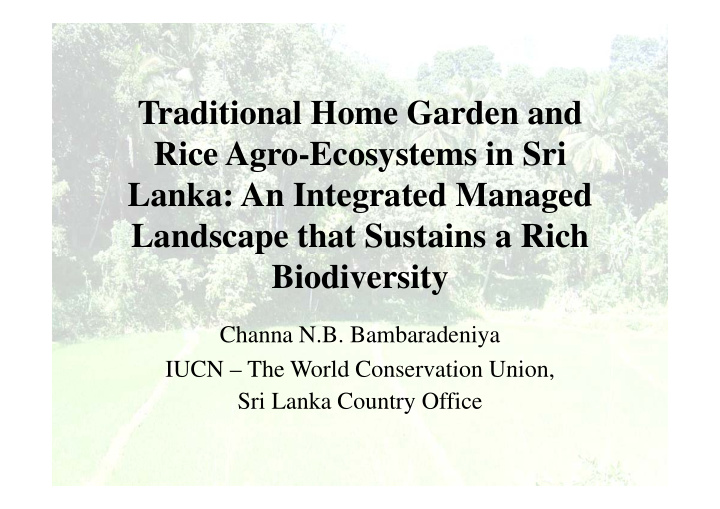



Traditional Home Garden and Rice Agro-Ecosystems in Sri Lanka: An Integrated Managed Lanka: An Integrated Managed Landscape that Sustains a Rich Biodiversity Channa N.B. Bambaradeniya IUCN IUCN – The World Conservation Union, The World Conservation Union Sri Lanka Country Office
Biological Conservation Biological Conservation Pre-1980’s Post-1980’s Managed ecosystems Undisturbed natural (>75% of terrestrial environment) habitats, including PAs (small land area)
Traditional Home Garden Rice Field Traditional Home Garden-Rice Field Integrated Landscape g p • The THG (367,800 ha) and RF (780,000 ha) agro-ecosystems are distributed throughout Sri Lanka. • Together, they cover approximately 15% of the terrestrial landscape in the island. the terrestrial landscape in the island. • According to historical evidence, this integrated agricultural system has been integrated agricultural system has been practiced in Sri Lanka for more than 2000 years years.
THG-RF Systems in Sri Lanka The THG-RF integrated agro-ecosystem comprise a rich mosaic of ecotones, harbouring a rich biological diversity. i h bi l i l di i
Floristic Composition of THG • A survey by Hochegger (1998) has enabled to document 640 species of plants • The species richness of plants range from The species richness of plants range from 22 – 170 (mean: 53 species) species of trees, shrubs and herbs per home garden (0 5 2 shrubs and herbs per home garden (0.5-2 ha).
Composition of Vertebrate Fauna in Composition of Vertebrate Fauna in THG-RF Agro-ecosystems g y • A total of 250 species, which represents about 40% of the total inland native vertebrate species in 40% f h l i l d i b i i Sri Lanka. • Among the vertebrate species recorded, 29 (12%) are endemic, while 40 (16%) are nationally threatened. • In addition to 133 species of native birds observed, p , 30 species of winter migratory birds were also documented
Richness of Invertebrates in Home Richness of Invertebrates in Home Gardens and Rice Fields and • A study in a 1 ha rice field in Sri Lanka enabled to document 494 species of invertebrates, under 10 phyla , p y – 82% arthropods; 40% aquatic species
The need to focus on Complimentary The need to focus on Complimentary Systems to PAs and Natural Habitats y Increasing demand for land for agricultural production and human habitations The number and size of protected areas set aside for biodiversity conservation is getting close to a ma im m maximum
Significance of THG-RF managed Significance of THG-RF managed landscapes for biodiversity conservation • The integrated THG-RF systems contribute to sustain biodiversity outside protected areas and i bi di i id d d natural ecosystems. • They serve in linking fragmented natural forests y g g and wetlands, as complementary corridors that facilitate the movement of wild animals.
Issues • THG-RF agro-ecosystems have been maintained in a sustainable manner over many millenia. y • Modern agricultural practices have caused profound modifications to traditional profound modifications to traditional managed landscapes, disrupting the ecology of these systems.
The Way Forward F Farmers, agriculturists and conservation biologists i lt i t d ti bi l i t should work closely to conserve and sustain traditional agricultural systems 。 agricultural systems 。 They should promote/maintain a mosaic of habitats, within the wider agricultural landscape. Th Thank You k Y
Recommend
More recommend